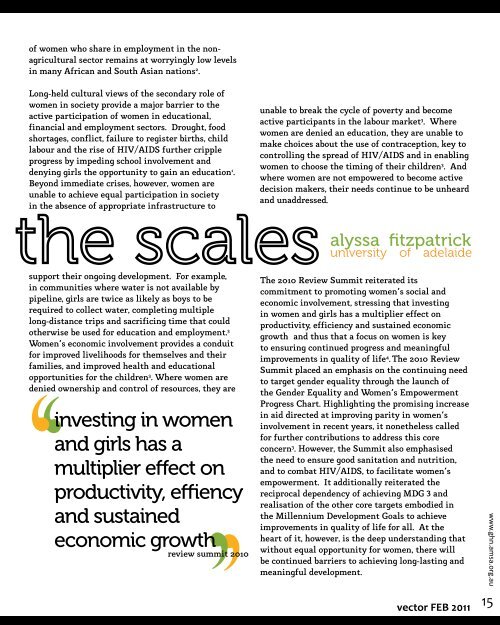Create successful ePaper yourself
Turn your PDF publications into a flip-book with our unique Google optimized e-Paper software.
of women who share in employment in the nonagricultural<br />
sector remains at worryingly low levels<br />
in many African and South Asian nations 2 .<br />
Long-held cultural views of the secondary role of<br />
women in society provide a major barrier to the<br />
active participation of women in educational,<br />
financial and employment sectors. Drought, food<br />
shortages, conflict, failure to register births, child<br />
labour and the rise of HIV/AIDS further cripple<br />
progress by impeding school involvement and<br />
denying girls the opportunity to gain an education 1 .<br />
Beyond immediate crises, however, women are<br />
unable to achieve equal participation in society<br />
in the absence of appropriate infrastructure to<br />
unable to break the cycle of poverty and become<br />
active participants in the labour market 3 . Where<br />
women are denied an education, they are unable to<br />
make choices about the use of contraception, key to<br />
controlling the spread of HIV/AIDS and in enabling<br />
women to choose the timing of their children 3 . And<br />
where women are not empowered to become active<br />
decision makers, their needs continue to be unheard<br />
and unaddressed.<br />
alyssa fitzpatrick<br />
university of adelaide<br />
support their ongoing development. For example,<br />
in communities where water is not available by<br />
pipeline, girls are twice as likely as boys to be<br />
required to collect water, completing multiple<br />
long-distance trips and sacrificing time that could<br />
otherwise be used for education and employment. 3<br />
Women’s economic involvement provides a conduit<br />
for improved livelihoods for themselves and their<br />
families, and improved health and educational<br />
opportunities for the children 3 . Where women are<br />
denied ownership and control of resources, they are<br />
‘‘<br />
investing in women<br />
‘‘<br />
and girls has a<br />
multiplier effect on<br />
productivity, effiency<br />
and sustained<br />
economic growth<br />
review summit 2010<br />
The 2010 Review Summit reiterated its<br />
commitment to promoting women’s social and<br />
economic involvement, stressing that investing<br />
in women and girls has a multiplier effect on<br />
productivity, efficiency and sustained economic<br />
growth” and thus that a focus on women is key<br />
to ensuring continued progress and meaningful<br />
improvements in quality of life 4 . The 2010 Review<br />
Summit placed an emphasis on the continuing need<br />
to target gender equality through the launch of<br />
the Gender Equality and Women’s Empowerment<br />
Progress Chart. Highlighting the promising increase<br />
in aid directed at improving parity in women’s<br />
involvement in recent years, it nonetheless called<br />
for further contributions to address this core<br />
concern 3 . However, the Summit also emphasised<br />
the need to ensure good sanitation and nutrition,<br />
and to combat HIV/AIDS, to facilitate women’s<br />
empowerment. It additionally reiterated the<br />
reciprocal dependency of achieving MDG 3 and<br />
realisation of the other core targets embodied in<br />
the Millennium Development Goals to achieve<br />
improvements in quality of life for all. At the<br />
heart of it, however, is the deep understanding that<br />
without equal opportunity for women, there will<br />
be continued barriers to achieving long-lasting and<br />
meaningful development.<br />
www.ghn.amsa.org.au<br />
vector FEB <strong>2011</strong><br />
15

















